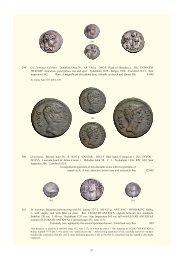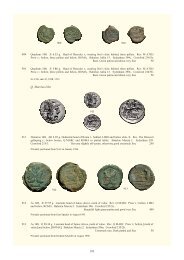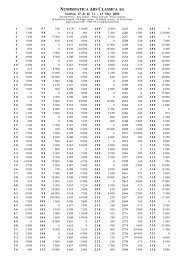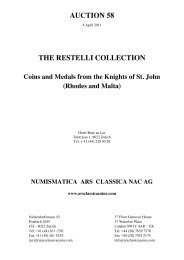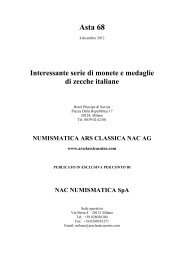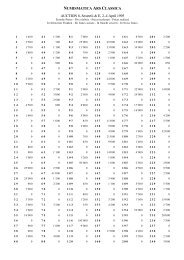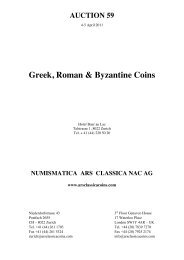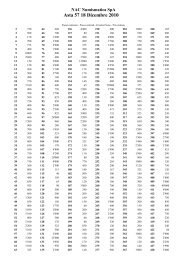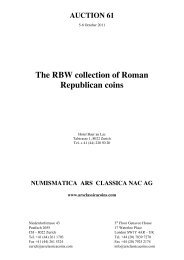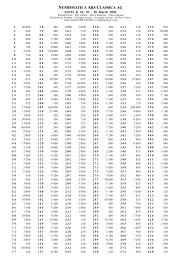The RBW collection of Roman Republican coins part II
The RBW collection of Roman Republican coins part II
The RBW collection of Roman Republican coins part II
You also want an ePaper? Increase the reach of your titles
YUMPU automatically turns print PDFs into web optimized ePapers that Google loves.
C. Cassius and M. Servilius.529529 Denarius, mint moving with Brutus and Cassius 43-42, AR 3.85 g. C·CASSI·IMP Laureate head <strong>of</strong> Libertasr. Rev. M·SERVILIVS – LEG Aplustre, the branches ending in flowers. Babelon Cassia 21 and Servilia 42.Sydenham 1312. Sear Imperators 225. Crawford 505/2.Extremely rare. Toned and about very fine 3’000Ex NAC sale 9, 1996, 762.Interestingly, this denarius is rarer than the corresponding aureus, Cr. 505/1 (<strong>RBW</strong>).Plutarch held Cassius in low regard, describing him as a man who was not well liked and who ruled his soldiers throughfear. He says: “...Cassius was known to be a man <strong>of</strong> violent and uncontrolled passions, whose craving for money had <strong>of</strong>tentempted him to stray from the path <strong>of</strong> justice, and it therefore seemed natural that his motive for fighting, wandering aboutthe empire and risking his life was not to win liberty for his fellow-countrymen, but to secure some great place forhimself.” Plutarch has precisely the opposite to say <strong>of</strong> Cassius’ co-conspirator: “Brutus’ virtues, on the other hand, madehim popular with the rank and file, beloved by his friends, and admired by the nobility, while even his enemies found itimpossible to hate him.”With this in mind one can imagine the simmering conflict between the two leaders, with Cassius being increasinglyresentful <strong>of</strong> Brutus’ popularity while he himself suffered from doing the lion’s share <strong>of</strong> the hard work, regardless <strong>of</strong> how ittarnished his reputation. In point <strong>of</strong> truth, their rivalry no less significant than the one being experienced by theiropponents, Marc Antony and Octavian. By the time they met at Sardis and were hailed imperator by their troops, thestrains <strong>of</strong> <strong>part</strong>nership reached an intolerable pitch. Plurarch states: “...as <strong>of</strong>ten happens in great enterprises in which a largenumber <strong>of</strong> friends and commanders are engaged, there had been some sharp differences and mutual accusations had beenexchanged. So...their first action was to meet in a room face to face. <strong>The</strong> doors were shut, and with no one else present thetwo men first began blaming one another and then fell to recriminations and counter-charges. <strong>The</strong>se soon led to indignantreproaches and tears, and their friends, who were amazed at the vehemence and bitterness <strong>of</strong> their anger, were afraid thatthe quarrel might end in violence.” This confrontation occurred just before Brutus de<strong>part</strong>ed to campaign disastrously inLycia and Cassius set out to capture Rhodes, which he did successfully, but with extreme severity.We may be sure this denarius was struck after Cassius’ defeat <strong>of</strong> the Rhodians, for the reverse depicts an aplustre, a shipornament that symbolized naval victory. <strong>The</strong> flowers at the extremities <strong>of</strong> the ornament suggest Rhodes since the rose hadbeen the symbol <strong>of</strong> that island for many centuries. Its symbolism is sealed when the other issue <strong>of</strong> this legate is considered:it shows a crab holding an aplustre in its claws, above a loose diadem and a rose. This rose is a certain reference toRhodes, and it appears below the crab, the badge <strong>of</strong> the island <strong>of</strong> Cos, near where decisive battle took place. <strong>The</strong> looseneddiadem might symbolize the kingship Cassius claimed to have undone at Rhodes (Plutarch, Brutus, 30) or it could be areference to the undoing <strong>of</strong> Julius Caesar’s tyranny some two years before.530530 Denarius, mint moving with Brutus and Cassius 43-42, AR 3.90 g. C·CASSEI·IMP Laureate head <strong>of</strong>Libertas r. Rev. M·SERVILIVS – LEG Crab, holding aplustre in its claws; below, rose and untied diadem.Babelon Cassia 19 and Servilia 40. C 10. Sydenham 1313. Sear Imperators 226. Crawford 505/3.Extremely rare and among the finest specimens known. Lightly toned and extremely fine 10’000Ex SKA Bern 1, 1983, 254 and NAC 9, 1996, 763 sales.120




